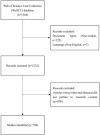Bibliometric analysis of intestinal microbiota and lung diseases
- PMID: 38426014
- PMCID: PMC10902173
- DOI: 10.3389/fcimb.2024.1347110
Bibliometric analysis of intestinal microbiota and lung diseases
Abstract
Background: Increasing evidence suggests a close association between the intestinal microbiome and the respiratory system, drawing attention to studying the gut-lung axis. This research employs bibliometric methods to conduct a visual analysis of literature in the field of intestinal microbiota and lung diseases over the past two decades. It offers scientific foundations for research directions and critical issues in this field.
Methods: We retrieved all articles on intestinal microbiota and lung diseases from the SCI-Expanded of WoSCC on October 25, 2023. The analysis included original articles and reviews published in English from 2011 to 2023. We utilized Python, VOSviewer, and CiteSpace to analyze the retrieved data visually.
Results: A total of 794 publications were analyzed. China ranked first in the number of publications, while the United States had the highest citations and H-index. Jian Wang was the most prolific author. Zhejiang University was the institution with the highest number of publications. Frontiers in Microbiology was the journal with the most publications. Author keywords appearing more than 100 times included "intestinal microbiota/microbiome", "microbiota/microbiome", and "gut-lung axis".
Conclusion: The correlation and underlying mechanisms between intestinal microbiota and lung diseases, including asthma, COPD, lung cancer, and respiratory infections, remain hot topics in research. However, understanding the mechanisms involving the gut-lung axis is still in its infancy and requires further elucidation.
Keywords: Citespace; VOSviewer; bibliometric analysis; intestinal microbiota; lung.
Copyright © 2024 Sun, Zhou, Ding, Guo, Zhou and Long.
Conflict of interest statement
The authors declare that the research was conducted in the absence of any commercial or financial relationships that could be construed as a potential conflict of interest.
Figures












References
MeSH terms
LinkOut - more resources
Full Text Sources
Medical
Miscellaneous

